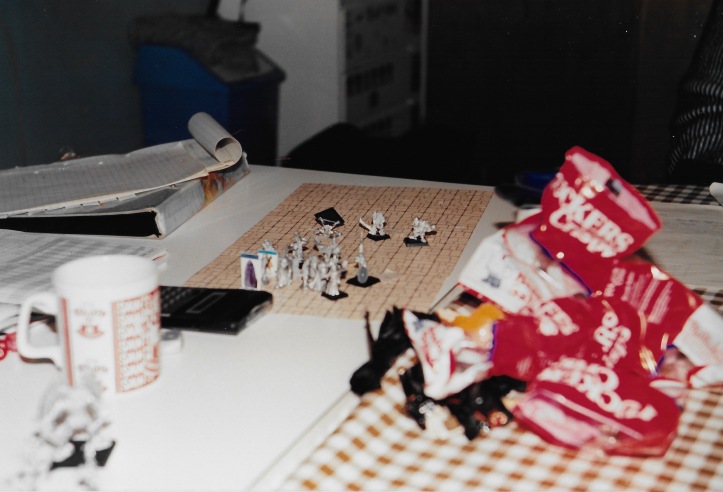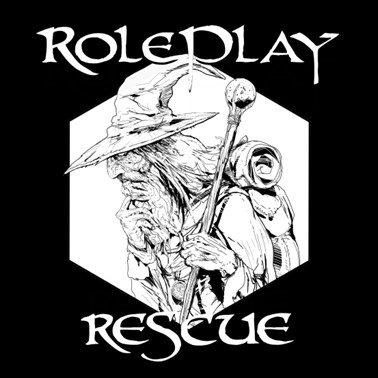When I was first playing Traveller, Dungeons & Dragons, Star Frontiers, and Rolemaster – the primary games we played together back in the early to mid 1980s – the expectations on the GM were lower than they are today.
Back then, we turned up and the GM ran the game as best as they knew how. By 1989, when I left home and went to University, the GM was using some miniatures and dungeon floor plan sections to help visualise the combat scenes… and everything else was verbal and conjured in the imagination by description. But the minis were a rare thing, really.

Today, as a GM playing on an online VTT, the expectations feel like they are vastly increased. Groups who enjoy using digital battle maps expect the GM to beautifully render their dungeons in high-quality and add visual effects, such as animated tokens and dynamic lighting. On top of this, many gamers expect the GM to voice act the NPCs and produce many other visual aids to help bring to life the campaign.
Players expect to see maps that I rarely ever saw back at the beginning. The idea of the players seeing a beautifully-drawn “poetic” map of the campaign world would have seemed laughable. We were lucky to have a pencil sketch of the immediate situation with a rough indication of distances. Where the GM used commercially available maps – such as the interior map of the starship in Star Frontiers‘ introductory adventure, “Crash on Volturnus” – we were aware that this was a luxurious exception.
While I think it’s wonderful that enterprising GMs who have the digital drawing skills have led the way in producing stunning props for their groups, the pressure on mere mortals like me has felt crushing. Over the years, I have commissioned maps and artwork to grace my tables with colour and beauty but in the grand scheme it rarely seems worth the effort when players brush it off as barely meeting their expectations.

I feel that the pursuit of roleplaying has, over time, become less accessible to anyone who doesn’t have the means to make or purchase a large collection of digital artwork. If you want to make your own world map for the setting of your own design, it’s on you to learn to use highly time-consuming apps or pay for a professional to render things for you. You suffer by comparison if you don’t.
In some circles, the appeal to the “Theatre of The Mind” is met with barely-concealed scorn and the complaint that you cannot expect all players to picture the scene without an actual image to reference is common. Of course, as with all things, this is not universal by any means… but the expectations of players do often seem very unrealistic.
The solution is to talk to players and help them to have more realistic expectations.
For me, given my professional and personal commitments, these kinds of expectations are not realistic. I don’t have the inclination to learn to use graphical tools long enough, with enough of an investment of time, to gain the skills needed to deliver. It’s simply not my forte, not my strength. But I have punished myself for not meeting these expectations for years. That has been a self-inflicted wound from which I am still recovering.
I sometimes feel that, as a GM, I am being pushed out of the enjoyment of roleplaying games by this incessant drive to be more than simply the guy who makes up a cool adventure, roleplays the NPCs (without necessarily doing voice or actual acting), and adjudicates the game rules. I suspect that a big driver for my own desire to ditch VTTs and bring things back to real dice, real character sheets, and deeper description has been a reaction to this trend for “more visuals, please!”
But of course, the reality is that when I feel this way I am accepting the premise of the expectations around me. I need to offer what I believe is enough for a good game. If players don’t like that, I guess they will vote with their feet. As culture changes, GMs like me are perhaps left behind and that’s perhaps simply the way of things.
Game on!

Permit me to posit a question that might be deemed closed-minded. It is not intended that way. Just a question. Has the popularity of 5e and all the associated products, as well as the way the game is marketed, as well as the examples set by various popular actual play video shows created this issue of GM Mission-Creep and absurd expectations by players? I feel lucky that my group is composed of friends from the last 43 years of my life.
LikeLiked by 2 people
Good article. While I’ve seen a lot of stuff on Twitter about digital art and maps, I’ve never felt much of that pressure in my games. I’ve used battle maps and what have you a couple of times – and I have to shout out Free League and Cubicle 7 for the amazing Foundry modules they make for Alien and WFRP respectively – but in my experience – even when playing with strangers at cons – the expectation is usually Theatre of the Mind. Roleplaying is ultimately a hobby of imagination, and I think that’s why most folks get into it. Either that, or this is me justifying my lack of artistic talent 😉
LikeLiked by 1 person
I think you are definitiely onto something. I happen to like map drawing, despite a lack of skill, and run a lot of tactical games that derive benefit from map and token displays.
– Theatre of the mind is more than fine in my book and I know my players are a mix of prefering maps and those that are happy without (and that’s D&D4e!).
– There are a lot of preprepared maps out there now, more freely available than 40 years ago, so supply may have expanded to meet expectation. This isn’t necessarily a good thing.
– Something like Dungeon Alchemist is made for a person like me, who isn’t very artistic, so they put in an AI that develops and builds the map for you. The results are stunning and, crucially, take minutes to come up with something. This isn’t necessarily a good thing.
– Lots of games do not derive much benefit from maps. They are not fine detailed on ranges and protagonist positioning, rather looking at zone and other narrative cues rather than my past miniature gaming precision. (Some games I think benefit from them, but even then they are not strictly necessary)
– I think game design has moved in your direction. The expectations on GMs has also shifted in some game design. For some colaborative, shared story games, extensive prep is actually a hinderence as the tools of the game support on the fly creation and the collaborative process provides a greater narraitive agency than routinely expected 40 years ago. (and I’m sure you could argue that thise principles could apply to games that have traditional expectations of table roles).
– Having a good story and great interactions are the core and what is important. I can lose myself in the process of bling and not have good story opportunities thought through. So, if anything, I’d say your priorities are bang on.
I can see where you are coming from with this, and agree with your instincts (even if I do spend too long making assets)
LikeLiked by 1 person
Good post.
I’ve never used VTT and probably won’t either, and I’m not going to start acting out different voices as it would soon rapidly degenerate into stereotypes.
Have a look at Diagrams.net which is a free web-based tool which allows you to draw simple sketches. It’s a bit like having graph paper and a set of pens and rulers.
LikeLike
Everything is anecdotal, but remember all those ads in Dragon magazine back in the day for mats, tiles, walls and minis. And remember walking into the game store and seeing walls and walls full of little lead sculptures. Remember your OD&D booklets proudly stating that you could use your miniatures with this game! We always played with some kind of token, and at least a mat and markers. I do the equivalent on my VTT. “Theater of the Mind” wasn’t a phrase used with 1970s RPGs. And you’re not going to be able to run an involved combat encounter if you can’t see where everyone is and what features of the environment you can interact with. And you can’t expect to do a hex crawl without a hex map. Don’t feel pressure to provide a video-game environment, but give the players the visual tools they need. No one can accurately visualize the same thing their DM is visualizing.
LikeLiked by 1 person